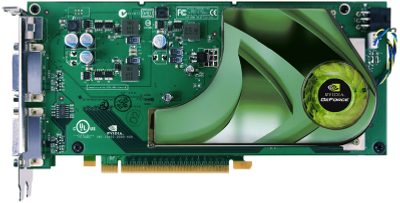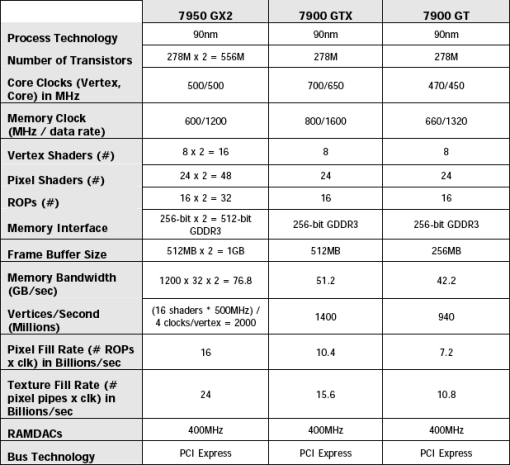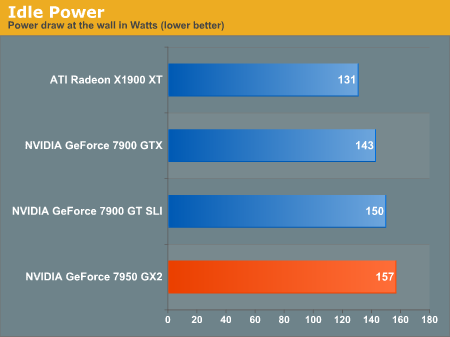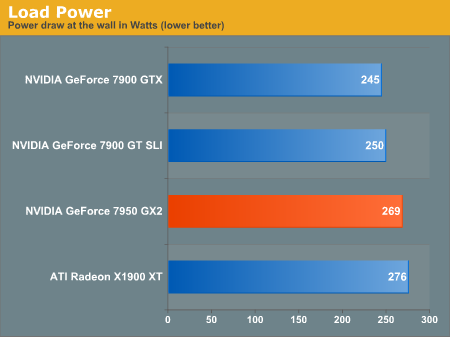NVIDIA Single Card, Multi-GPU: GeForce 7950 GX2
by Derek Wilson on June 5, 2006 12:00 PM EST- Posted in
- GPUs
The Card and The Test
This is one of the most unique consumer level graphics boards we have seen in quite a long time. While there have been a few card makers that have dropped two GPUs on one board, this is the first product where we have seen PCIe switch technology used to actually allow the connection of two independent PCIe devices in one slot. The 7950 GX2 is also the first consumer level graphics add-in product we've had in our labs to be built using two separate PCBs.

If we take a close look at the card itself, we can see the PCIe connection between the two boards. This is an X8 PCIe connection, which saves a bit on board routing requirements and physical connector width. Even though PCIe is a serial bus and each new lane only requires two additional wires, NVIDIA had a lot on their hands when designing this product. The first incarnation in the 7900 GX2 currently being used in Quad SLI systems routes all 16 lanes to each graphics card, but the board itself is much larger than the 7950 GX2. It doesn't seem like just cutting down the PCIe lanes would make enough difference to cut out so much board space, so it is likely that NVIDIA spent further time optimizing board features and layout.

The board does have an open SLI connector. Unfortunately, at this time, we have not been able to test DIY Quad SLI. NVIDIA has made it clear that they won't try to stop people from building their own Quad SLI systems, but they also won't actively support such activity. This is in line with their current stance on overclocking. At the moment, NVIDIA tells us that there are many roadblocks to configuring a working Quad SLI system with the 7950 GX2.
On top of BIOS issues with a single PCIe bridge in one X16 slot, supporting multiple bridges and four graphics cards might be beyond the capability of most motherboards at this point. Again, the physical ability is there, but BIOS support may still be lacking. Driver support is also a problem, as the drivers that support the 7950 GX2 do not support Quad SLI and vice versa. NVIDIA assures us that driver support should eventually come along, but until then we will be working on hacking our way around these issues.
As for multiple display capabilities, the 7950 GX2 is just like single GPU boards. There are only two DVI outputs onboard which both support dual-link bandwidth and are driven by only one of the GPUs. NVIDIA has confirmed that it is technically possible to provide 4 dual-link DVI outputs on one 7950 GX2 board, but it doesn't look like any board makers are going down that route. There may also be additional driver support necessary to make this happen, and demand might not ever get high enough to entice anyone to actually build a 7950 GX2 with all the necessary components. Still, it is nice to know that the only thing stopping someone from going down the quad output route is simply the cost of the connectors.
As we are still working on getting the 7950 GX2 set up in SLI with a second card, we will be focusing on a comparison with other single card solutions. The exception, of course, will be 7900 GT SLI. The specifications of the 7950 GX2 indicate that it should perform very similarly to a 7900 GT SLI setup without the hassle. Each GPU on the 7950 GX2 is essentially a higher clocked 7900 GT. Additionally, the 7950 GX2 incorporates 512MB of 1200MHz (effective data rate) GDDR3 for a total of 1GB of on board RAM. Here is a quick reference table NVIDIA provided showing the differences between the 7950 GX2, the 7900 GTX and the 7900 GT. We do take some issue with reporting memory bandwidth, fill rate, and verts/sec as simple aggregates of the two GPUs' capabilities as these quantities don't scale perfectly linearly in either an SLI setup or in the case of the 7950 GX2, but the data is still interesting.

For the rest of our comparisons, we will be looking at the solutions shown here:
AMD Athlon 64 FX-57
ASUS A8N32 SLI Deluxe NVIDIA nForce 4 X16 Motherboard
2GB 3:3:2:8 OCZ PC4000 EB
Seagate 7200.7 160GB HD
700W GameXStream PSU
NVIDIA GeForce 7950 GX2
NVIDIA GeForce 7900 GTX
NVIDIA GeForce 7800 GTX 512
NVIDIA GeForce 7900 GT (and SLI)
ATI Radeon X1900 XT
ATI Radeon X1900 GT
We will lead off with a side by side comparison of the 7950 GX2 and the 7900 GT SLI, and then we will take a look at how the 7950 GX2 stacks up against other high end parts. Before we get too that, here's a quick look at power.


Our power tests at idle show that the Radeon X1900 XT comes in at the prime spot, but the tables turn when we flip the switch on Splinter Cell. Under load, the 7950 GX2 drops in behind the X1900 XT in power consumption. This difference between the NVIDIA and ATI high end would be even more exaggerated if we tested the X1900 XTX which expends even more energy to increase performance only slightly. While the GeForce 7950 GX2 draws more power than it's NVIDIA brethren, we are still looking at a manageable power draw (especially when considering the incredibly high power requirements of 7900 GTX SLI or X1900 XT CrossFire in comparison).
This is one of the most unique consumer level graphics boards we have seen in quite a long time. While there have been a few card makers that have dropped two GPUs on one board, this is the first product where we have seen PCIe switch technology used to actually allow the connection of two independent PCIe devices in one slot. The 7950 GX2 is also the first consumer level graphics add-in product we've had in our labs to be built using two separate PCBs.

If we take a close look at the card itself, we can see the PCIe connection between the two boards. This is an X8 PCIe connection, which saves a bit on board routing requirements and physical connector width. Even though PCIe is a serial bus and each new lane only requires two additional wires, NVIDIA had a lot on their hands when designing this product. The first incarnation in the 7900 GX2 currently being used in Quad SLI systems routes all 16 lanes to each graphics card, but the board itself is much larger than the 7950 GX2. It doesn't seem like just cutting down the PCIe lanes would make enough difference to cut out so much board space, so it is likely that NVIDIA spent further time optimizing board features and layout.

The board does have an open SLI connector. Unfortunately, at this time, we have not been able to test DIY Quad SLI. NVIDIA has made it clear that they won't try to stop people from building their own Quad SLI systems, but they also won't actively support such activity. This is in line with their current stance on overclocking. At the moment, NVIDIA tells us that there are many roadblocks to configuring a working Quad SLI system with the 7950 GX2.
On top of BIOS issues with a single PCIe bridge in one X16 slot, supporting multiple bridges and four graphics cards might be beyond the capability of most motherboards at this point. Again, the physical ability is there, but BIOS support may still be lacking. Driver support is also a problem, as the drivers that support the 7950 GX2 do not support Quad SLI and vice versa. NVIDIA assures us that driver support should eventually come along, but until then we will be working on hacking our way around these issues.
As for multiple display capabilities, the 7950 GX2 is just like single GPU boards. There are only two DVI outputs onboard which both support dual-link bandwidth and are driven by only one of the GPUs. NVIDIA has confirmed that it is technically possible to provide 4 dual-link DVI outputs on one 7950 GX2 board, but it doesn't look like any board makers are going down that route. There may also be additional driver support necessary to make this happen, and demand might not ever get high enough to entice anyone to actually build a 7950 GX2 with all the necessary components. Still, it is nice to know that the only thing stopping someone from going down the quad output route is simply the cost of the connectors.
As we are still working on getting the 7950 GX2 set up in SLI with a second card, we will be focusing on a comparison with other single card solutions. The exception, of course, will be 7900 GT SLI. The specifications of the 7950 GX2 indicate that it should perform very similarly to a 7900 GT SLI setup without the hassle. Each GPU on the 7950 GX2 is essentially a higher clocked 7900 GT. Additionally, the 7950 GX2 incorporates 512MB of 1200MHz (effective data rate) GDDR3 for a total of 1GB of on board RAM. Here is a quick reference table NVIDIA provided showing the differences between the 7950 GX2, the 7900 GTX and the 7900 GT. We do take some issue with reporting memory bandwidth, fill rate, and verts/sec as simple aggregates of the two GPUs' capabilities as these quantities don't scale perfectly linearly in either an SLI setup or in the case of the 7950 GX2, but the data is still interesting.

For the rest of our comparisons, we will be looking at the solutions shown here:
AMD Athlon 64 FX-57
ASUS A8N32 SLI Deluxe NVIDIA nForce 4 X16 Motherboard
2GB 3:3:2:8 OCZ PC4000 EB
Seagate 7200.7 160GB HD
700W GameXStream PSU
NVIDIA GeForce 7950 GX2
NVIDIA GeForce 7900 GTX
NVIDIA GeForce 7800 GTX 512
NVIDIA GeForce 7900 GT (and SLI)
ATI Radeon X1900 XT
ATI Radeon X1900 GT
We will lead off with a side by side comparison of the 7950 GX2 and the 7900 GT SLI, and then we will take a look at how the 7950 GX2 stacks up against other high end parts. Before we get too that, here's a quick look at power.


Our power tests at idle show that the Radeon X1900 XT comes in at the prime spot, but the tables turn when we flip the switch on Splinter Cell. Under load, the 7950 GX2 drops in behind the X1900 XT in power consumption. This difference between the NVIDIA and ATI high end would be even more exaggerated if we tested the X1900 XTX which expends even more energy to increase performance only slightly. While the GeForce 7950 GX2 draws more power than it's NVIDIA brethren, we are still looking at a manageable power draw (especially when considering the incredibly high power requirements of 7900 GTX SLI or X1900 XT CrossFire in comparison).










60 Comments
View All Comments
Exsomnis - Monday, June 5, 2006 - link
Since when did slapping two PCBs together = single card? *Confused.*z3R0C00L - Monday, June 5, 2006 - link
Marketing Gimmick...It's two GPU's. It's SLI. The Fastest Single VPU/GPU solution is the x1900XTX (not tested here).
The most advanced GPU/VPU is the x1900XTX as well.
I wonder if these crds will also suffer from the 50% failure rate other 7900 series cards suffer from.
Jojo7 - Monday, June 5, 2006 - link
Haha. 50% failure rate. That's comedy.Where'd you pull that number from?
Hardocp said BFG reported 3-5%, Evga reported .04-1.9%, XFX said in the last 2 weeks they reported a .5% (half of one percent) increase in RMA's.
Yea. That seems like 50% to me.
Xenoid - Monday, June 5, 2006 - link
50% failure rate might be bullshit but the fact that you completely ignored the other half of his message is also bullshit fanboy-ism.The X1900 XTX isn't on here. The X1900 XT Crossfire isn't on here either, but the 7900 GT SLI is. This review is missing 2 of the top video cards, and for what reason? It makes this review incomplete and this should be addressed.
Jojo7 - Monday, June 5, 2006 - link
Actually, I agree with both of your points. The x1900 XTX should have been included in this review in both crossfire and single card. To the same end, the 7900 GTX in sli should have been included imo.
Noise comparisons and power draws would have been nice as well.
DerekWilson - Monday, June 5, 2006 - link
this does touch on our motivation --the 7950 GX2 is a single board solution (for those uncomortable with the inclusion of 2 PCBs, think of one as a daughterboard or something). We wanted to really focus on the comparison to other single board solutions.
Right now x1900 crossfire and 7900 gtx sli are over $1000 investments, and don't really compete with the 7950 GX2 -- unless we look at the 7950 GX2 in SLI. As we couldn't get quad SLI on the 7950 GX2 working for this article, we decided we save the comparison to that copetition later. It does seem pretty clear fromt these tests that the 7950 GX2 in SLI will be able to trump any other solution in its market segment.
Also, the 7950 GX2 doesn't require an SLI board -- which is a great advantage of current multi-GPU solutions. In many cases, putting two other solutions in SLI won't be an option for users who upgrade to a 7950 GX2.
But
Please understand that I certainly appreciate the requests for the inclusion of the 1900xt crossfire and the 7900 gtx crossfire as a reference point to what is currently possible on the highest end of the spectrum. In future articles involving the 7950 GX2 we will address this issue. Thanks very much for your feedback.
poohbear - Thursday, June 8, 2006 - link
50% failure rate? dude, do u know how this percentage thing works?! that would mean 1 in 2 79XX cards fail. please, bs is a great thing and we have plenty of it on the net, but try to atleast make your bs somewhat believable.nullpointerus - Monday, June 5, 2006 - link
No, it isn't. They only wanted to reply to a particular point within his post.
Inkjammer - Monday, June 5, 2006 - link
50% failure rate? Where are you getting those numbers from?z3R0C00L - Monday, June 5, 2006 - link
I got the number from polling various website forums.. including HardOCP.eVGA, XFX and BFG claim low to non-existant issues. My polls show an avg of 48% failure rate. It's on HardOCP... go and check out the forums.